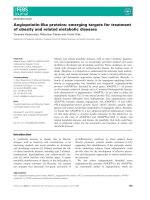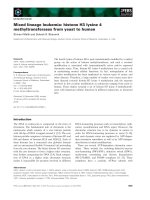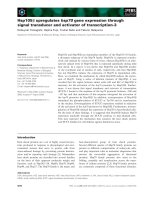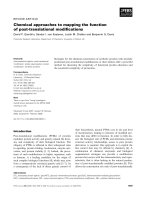Tài liệu Báo cáo khoa học: Angiopoietin-like proteins: emerging targets for treatment of obesity and related metabolic diseases pptx
Bạn đang xem bản rút gọn của tài liệu. Xem và tải ngay bản đầy đủ của tài liệu tại đây (129.15 KB, 6 trang )
MINIREVIEW
Angiopoietin-like proteins: emerging targets for treatment
of obesity and related metabolic diseases
Tsuyoshi Kadomatsu, Mitsuhisa Tabata and Yuichi Oike
Department of Molecular Genetics, Graduate School of Medical Sciences, Kumamoto University, Japan
Introduction
A worldwide increase in obesity due to lifestyle
changes, such as inactivity and overnutrition, is an
increasing medical and social problem in developed
and developing countries [1]. Obesity increases the risk
of related metabolic diseases, including type 2 diabetes,
hypertension, hyperlipidemia and cardiovascular dis-
ease [2], which interfere with healthy aging. A major
metabolic manifestation of obesity in the early phase is
systemic insulin resistance [3]. Recently, the concept
has emerged that persistent low-grade activation of
proinflammatory pathways in obese adipose tissue
directly promotes systemic insulin resistance [1,4,5],
suggesting that identification of the molecular mecha-
nisms underlying adipose tissue inflammation could
provide clues for the development of effective preven-
tive and therapeutic approaches to obesity-related insu-
lin resistance.
We and others independently identified seven
angiopoietin-like proteins (ANGPTLs) [6]. ANGPTLs
are structurally similar to angiopoietins, which are
Keywords
adipose tissue; ANGPTL2; ANGPTL6 ⁄ AGF;
cardiovascular disease; chronic
inflammation; energy metabolism;
insulin resistance; metabolic syndrome;
obesity; obesity-related metabolic disease
Correspondence
Y. Oike, Department of Molecular Genetics,
Graduate School of Medical Sciences,
Kumamoto University, 1-1-1 Honjo,
Kumamoto 860-8556, Japan
Fax: +81 96 373 5145
Tel: +81 96 373 5140
E-mail:
Note
Tsuyoshi Kadomatsu and Mitsuhisa Tabata
contributed equally to this work
(Received 21 July 2010, revised 21
November 2010, accepted 29 November
2010)
doi:10.1111/j.1742-4658.2010.07979.x
Obesity and related metabolic diseases, such as type 2 diabetes, hyperten-
sion and hyperlipidemia are an increasingly prevalent medical and social
problem in developed and developing countries. These conditions are asso-
ciated with increased risk of cardiovascular disease, the leading cause of
death. Therefore, it is important to understand the molecular basis underly-
ing obesity and related metabolic diseases in order to develop effective pre-
ventive and therapeutic approaches against these conditions. Recently, a
family of proteins structurally similar to the angiogenic-regulating factors
known as angiopoietins was identified and designated ‘angiopoietin-like
proteins’ (ANGPTLs). Encoded by seven genes, ANGPTL1–7 all possess
an N-terminal coiled-coil domain and a C-terminal fibrinogen-like domain,
both characteristic of angiopoietins. ANGPTLs do not bind to either the
angiopoietin receptor Tie2 or the related protein Tie1, indicating that these
ligands function differently from angiopoietins. Like angiopoietins, some
ANGPTLs potently regulate angiogenesis, but ANGPTL3, -4 and ANG-
PTL6 ⁄ angiopoietin-related growth factor (AGF) directly regulate lipid,
glucose and energy metabolism independent of angiogenic effects. Recently,
we found that ANGPTL2 is a key adipocyte-derived inflammatory media-
tor that links obesity to systemic insulin resistance. In this minireview, we
focus on the roles of ANGPTL2 and ANGPTL6 ⁄ AGF in obesity and
related metabolic diseases, and discuss the possibility that both could func-
tion as molecular targets for the prevention and treatment of obesity and
metabolic diseases.
Abbreviations
AGF, angiopoietin-related growth factor; ANGPTL, angiopoietin-like protein; PGC-1a, peroxisome proliferator-activated receptor-c (PPARc)
coactivator 1a; PPAR, peroxisome proliferator-activated receptor.
FEBS Journal 278 (2011) 559–564 ª 2010 The Authors Journal compilation ª 2010 FEBS 559
characterized by a coiled-coil domain in the N-termi-
nus and a fibrinogen-like domain in the C-terminus.
Angiopoietins have a signal sequence in the N-termi-
nus for protein secretion, and secreted angiopoietin
functions to maintain the vascular system and hemato-
poietic stem cells through the Tie2 receptor [6]. How-
ever, ANGPTLs do not bind to either Tie2 or the
related protein Tie1, suggesting that these orphan
ligands function differently from angiopoietins. Cells
transfected with expression vectors encoding ANG-
PTL1, -2, -3, -4 or -6 secrete each ANGPTL protein
into culture supernatants [7–9], and ANGPTL2, -3, -4
and -6 have been detected in the systemic circulation,
suggesting that at least some ANGPTLs function in an
endocrine manner in vivo [7,10–13]. Several studies
show that most ANGPTLs potently regulate angiogen-
esis, whereas a subset also functions in glucose, lipid
and energy metabolism [6]. For example, ANGPTL3
and ANGPTL4 regulate lipid metabolism by inhibiting
lipoprotein lipase activity [6,11,12]. ANGPTL6 ⁄ angio-
poietin-like growth factor (AGF) reportedly counter-
acts obesity by increasing systemic energy expenditure
and thereby antagonizing related metabolic diseases
[14]. Furthermore, we recently reported that ANG-
PTL2 causes inflammation of adipose tissue in obesity
and related insulin resistance [15]. Here, we focus on
the roles of ANGPTL2 and ANGPTL6 ⁄ AGF in obes-
ity and related metabolic diseases, and discuss whether
these ANGPTLs could be targets for the prevention
and treatment of these conditions.
Suppression of ANGPTL2 as an
effective strategy against
obesity-related insulin resistance
It is well known that lifestyle intervention is the best
strategy to overcome obesity and related metabolic dis-
eases; however, it is difficult for busy people to follow
recommended regimes on a daily basis. An alternative
strategy might be to suppress inflammation in obese
adipose tissue, which secretes numerous inflammatory
molecules that mediate insulin resistance in skeletal
muscle and ⁄ or vascular dysfunction in blood vessels,
leading to type 2 diabetes and ⁄ or cardiovascular dis-
ease. Although peroxisome proliferator-activated
receptor (PPAR)c agonists used in clinical practice
effectively ameliorate adipose tissue inflammation and
systemic insulin sensitivity, they have potential side
effects, such as increased body weight (adiposity
and ⁄ or edema), altered bone metabolism and undesir-
able long-term cardiovascular outcomes (Rosiglitaz-
one). For these reasons, the recently identified adipose
tissue-derived inflammatory mediator, ANGPTL2,
might be an alternative and more specific therapeutic
target against obesity-induced metabolic alterations.
ANGPTL2, a secreted protein, regulates angiogene-
sis similarly to several other ANGPTLs. However,
ANGPTL2 has the unique capacity to induce an
inflammatory response in blood vessels [15,16]. ANG-
PTL2 expression is induced by chronic but not acute
hypoxia [15]. Increased ANGPTL2 transcription
following hypoxia is not altered by mutations in the
hypoxia-inducible factor-1a response element found in
its promoter region (our unpublished data); thus regu-
lation is likely independent of hypoxia-inducible
factor-1a. Interestingly, ANGPTL2 is abundantly
expressed in adipose tissue [15]. ANGPTL2 mRNA
levels in adipose tissue and circulating protein levels
are both elevated in obese mice [15], consistent with
the finding that in obesity ANGPTL2 expression is
induced by both chronic hypoxia and endoplasmic
reticulum stress resulting from adipose tissue expan-
sion [15]. Further understanding of mechanisms
governing ANGPTL2 expression would be helpful in
treating obesity by suggesting ways to target ANG-
PTL2 expression. In humans, ANGPTL2 concentra-
tion in the circulation is also upregulated in obesity
(particularly visceral obesity) and correlated with the
levels of systemic insulin resistance and inflammation
[15]. Circulating ANGPTL2 levels decrease with body
weight reduction, likely reflecting the pathophysiologi-
cal effect (hypoxia and endoplasmic reticulum stress)
of adipose tissue. These findings support the possibility
that the alteration of circulating ANGPTL2 levels
could serve as a marker of obesity-induced metabolic
abnormalities. Furthermore, circulating ANGPTL2
levels decrease in parallel with reduction of visceral fat
in obese diabetic patients treated with pioglitazone, a
PPARc agonist with unique antidiabetic activity that
decreases visceral fat, suppresses inflammation and
ameliorates insulin sensitivity [15,17,18]. These findings
suggest that, in humans, visceral fat is one of the pri-
mary sources of circulating ANGPTL2. In addition,
ANGPTL2 mRNA expression in cultured 3T3-L1
adipocytes was halved 24 h after addition of a PPARc
agonist to the medium, which may in part explain
reduction in plasma ANGPTL2 levels following piog-
litazone treatment [15]. These results are compatible
with the observation that suppressing ANGPTL2 ame-
liorates insulin sensitivity in mice. The antidiabetic
effect of pioglitazone may be due in part to ANG-
PTL2 reduction.
Overexpression of ANGPTL2 in skin and adipose
tissues results in local inflammation as evidenced by
leukocyte attachment to the wall of post-capillary
venules and increased blood vessel permeability [15].
ANGPTLs in obesity and related metabolic diseases T. Kadomatsu et al.
560 FEBS Journal 278 (2011) 559–564 ª 2010 The Authors Journal compilation ª 2010 FEBS
However, the number of blood vessels remains unal-
tered by ANGPTL2 overexpression [15,16]. This find-
ing suggests that ANGPTL2 promotes vascular
inflammation rather than angiogenesis in these tissues,
although it has been shown to enhance endothelial cell
migration in vitro and in avascular tissues, such as the
cornea [15]. Transgenic mice expressing ANGPTL2 in
adipose tissue show vascular inflammation and
increased macrophage infiltration in adipose tissue,
although they are not obese [15]. The expression of
inflammatory cytokines (tumor necrosis factor-a, inter-
leukin-6 and interleukin-1b) was increased in the adi-
pose tissue of ANGPTL2 transgenic mice compared
with that of wild-type mice [15]. Conversely, ANG-
PTL2 null mice fed a high-fat diet show fewer infil-
trated macrophages and decreased tumor necrosis
factor-a and interleukin-6 expression in the adipose
tissue of ANGPTL2 null mice compared with that of
wild-type mice [15]. These results raise the possibility
that blocking ANGPTL2 signaling simultaneously sup-
presses the expression of other inflammatory cyto-
kines. In addition, because ANGPTL2 null mice
survive and grow normally, it is predicted that the
suppression of ANGPTL2 signaling has few side
effects. Therefore, for these reasons, we consider that
the suppression of ANGPTL2 signaling as a therapeu-
tic strategy is more beneficial.
Because ANGPTL2 promotes vascular inflammation
via the a5b1 integrin ⁄ Rac1 ⁄ NF-jB pathway [15] and
vascular injury accompanied by inflammation is con-
sidered an early feature of arteriosclerosis [19], circu-
lating ANGPTL2 may also function in obesity-related
insulin resistance but also obesity-related or unrelated
cardiovascular disease. Interestingly, the circulating
ANGPTL2 concentration in patients with coronary
artery disease is higher than that seen in healthy sub-
jects, even when there is no difference in body weight
between groups [15]. Moreover, endothelial cells from
tissue segments of internal mammary arteries from
smokers with coronary artery disease express higher
levels of ANGPTL2 mRNA than tissues from non-
smokers with similar disease [20]. Because smoking is
closely associated with the development of inflamma-
tion and increased risk of atherosclerosis [21], focal
ANGPTL2 secreted by vascular endothelial cells may
be a mediator linking smoking to cardiovascular
disease in an autocrine or paracrine manner. Blocking
ANGPTL2 signaling may also be beneficial also
in preventing and treating cardiovascular disease
(Fig. 1).
To date, integrins have been regarded as a func-
tional ANGPTL2 receptor. ANGPTL2 induces an
inflammatory cascade in blood endothelial cells
through a5b1 integrin receptors and promotes mono-
cyte chemotaxis through a4 and b2 integrin receptors
[15]. Angiopoietin signaling is regulated by two inde-
pendent receptors; Tie2 receptor and integrins [22].
Therefore, we cannot rule out the possibility that
endothelial cells and ⁄ or monocytes express a specific
ANGPTL2 receptor. Although further studies are
needed to identify a specific ANGPTL2 receptor and
its downstream effectors, strategies aimed at blocking
ANGPTL2 signaling through suppressing its expres-
sion, neutralizing secreted ANGPTL2 or blocking
Lifestyle changes
(inactivity, overnutrition, etc)
Obesity-related metabolic diseases
Hyperlipidemia
Hypertension
Type 2 diabetes
Insulin resistance
Chronic adipose tissue inflammation
Cardiovascular disease
ANGPTL2
Activation of vascular
inflammation and
monocyte migration
Enhancement of
systemic energy
expenditure
ANGPTL6/AGF
Anti-obesity effect
Improvement of
g
lucose intolerance
Induction
Obesity
Induction
Fig. 1. Schematic diagram showing the
roles of ANGPTL2 and ANGPTL6 ⁄ AGF in
obesity and related metabolic diseases.
The expression of ANGPTL2 and ANGPTL6 ⁄
AGF is induced in obese conditions.
ANGPTL2 induces chronic adipose tissue
inflammation and systemic insulin resistance
through the induction of vascular
inflammation and monocyte migration.
ANGPTL6 ⁄ AGF antagonizes obesity and
insulin resistance through the enhancement
of systemic energy expenditure. The solid
lines show effects that are through to be
direct, whereas dashed lines indicate what
are likely indirect or secondary effects.
T. Kadomatsu et al. ANGPTLs in obesity and related metabolic diseases
FEBS Journal 278 (2011) 559–564 ª 2010 The Authors Journal compilation ª 2010 FEBS 561
ANGPTL2 receptor activity or intracellular signaling
might constitute promising treatments for obesity and
metabolic diseases associated with chronic inflamma-
tion (Fig. 1).
Activation of ANGPTL6
⁄
AGF
counteracts obesity and related
metabolic diseases
ANGPTL6 ⁄ AGF, the angiopoietin-like protein most
closely related to ANGPTL2, is abundantly expressed
in liver, and expressed at relatively low levels in other
tissues [6]. ANGPTL6 ⁄ AGF exhibits a signal
sequence in the N-terminus and ANGPTL6 ⁄ AGF
protein is detected in the circulation, indicating that
it is secreted [9,13]. ANGPTL6 ⁄ AGF induces angio-
genesis and arteriogenesis through activation of the
ERK1 ⁄ 2–eNOS–NO pathway in endothelial cells
[6,9,16,23].
ANGPTL6 ⁄ AGF null mice show marked obesity
because of decreased energy expenditure and insulin
resistance [13,14,16]. By contrast, transgenic mice in
which ANGPTL6 ⁄ AGF expression is constitutive and
broadly driven by the CAG promoter (chicken b-actin
promoter with cytomegalovirus immediate-early enhan-
cer; CAG–ANGPTL6 ⁄ AGF mice) exhibit a lean phe-
notype with enhanced energy expenditure [13,14,16].
In wild-type mice, a high-fat diet causes obesity and
insulin resistance, whereas CAG–ANGPTL6 ⁄ AGF
mice are protected against diet-induced obesity and
insulin resistance [13]. K14–ANGPTL6 ⁄ AGF trans-
genic mice, which persistently overexpress ANG-
PTL6 ⁄ AGF in the skin, also exhibit increased
ANGPTL6 ⁄ AGF serum levels comparable with those
seen in CAG–ANGPTL6 ⁄ AGF transgenic mice and
exhibit a lean phenotype and increased insulin sensitiv-
ity [14]. Moreover, adenoviral overexpression of ANG-
PTL6 ⁄ AGF in the liver of diet-induced obese mice
results in elevated ANGPTL6 ⁄ AGF serum levels and
amelioration of diet-induced obesity and insulin resis-
tance [14]. Taken together, these findings suggest that
ANGPTL6 ⁄ AGF in the circulation counteracts obesity
and related insulin resistance by increasing systemic
energy expenditure.
A recent study indicates that circulating levels of
human ANGPTL6 ⁄ AGF are elevated in obese or
diabetic conditions [24]. Similarly, we found that
ANGPTL6 ⁄ AGF serum levels are elevated in not only
diet-induced obese mice and ob ⁄ ob mice, but also in
obese humans (unpublished data), suggesting that
increased circulating ANGPTL6 ⁄ AGF in obesity does
not reverse obesity at all. Furthermore, ANGPTL6 ⁄
AGF levels have been positively correlated with fasting
serum glucose levels [24]. These findings raise the
possibility that ANGPTL6 ⁄ AGF resistance occurs in
obese or diabetic conditions. Leptin, which is known
to reduce body weight by decreasing appetite and
increasing energy expenditure [25,26], has a positive
correlation with obesity [27]. Although under physio-
logical conditions leptin serves to counteract weight
gain, inflammation induces a state of ‘leptin resistance’
in obese animals and humans resulting in development
of hyperleptinemia. Similarly, hyperleptinemia is a
consequence of the development of insulin resistance
in obesity and type 2 diabetes. Thus, we consider that
although the normal production of ANGPTL6 ⁄ AGF
from liver may be upregulated to counteract weight
gain and promote insulin sensitivity, the effect of
ANGPTL6 ⁄ AGF might also be attenuated in the
obese state. Nonetheless, an approximately twofold
increase in serum ANGPTL6 ⁄ AGF levels by adenovi-
ral overexpression of ANGPTL6 ⁄ AGF results in
marked body weight reduction in diet-induced obese
mice that have two to three times higher ANGPTL6 ⁄
AGF levels than lean mice already [13], so ANGPTL6 ⁄
AGF resistance might be milder than leptin resistance.
Therefore, because ANGPTL6 ⁄ AGF transgenic mice
exhibit twofold-increased ANGPTL6 ⁄ AGF serum
levels and enhanced energy expenditure compared with
wild-type mice [13], they might be protected against
diet-induced obesity. As a next step to investigate this
possibility, further studies are needed to elucidate
how ANGPTL6 ⁄ AGF gene expression is regulated in
the liver and to define mechanisms underlying its
signaling.
Recent studies indicate that skeletal muscle regulates
energy expenditure, which is mediated by PPARa,
PPARd, PPARc and their coactivators, peroxisome
proliferator-activated receptor-c (PPARc) coactivator
(PGC)-1a and PGC-1b, in response to energy overload
[28–31]. We found significant decreases in the expression
of PPARd and PGC-1a in skeletal muscle in ANG-
PTL6 ⁄ AGF null mice, and increases in the expression
of PPARa, PPARd and PGC-1a in skeletal muscle of
ANGPTL6 ⁄ AGF transgenic mice [14]. Moreover,
ANGPTL6 ⁄ AGF protein binds to C2C12 myocytes and
stimulates phosphorylation of p38 MAPK [14], which
directly enhances stability and activation of PGC-1a
protein [30]. ANGPTL6 ⁄ AGF was also reported to sup-
press gluconeogenesis by activating the PI3K⁄ Akt⁄
FoxO1 pathway, decreasing glucose-6-phosphatase
expression in rat hepatocytes [32]. Because ANGPTL6 ⁄
AGF is primarily expressed in hepatocytes, it may
suppress gluconeogenesis in those cells in an auto-
crine ⁄ paracrine manner. Taken together, activation of
ANGPTL6 ⁄ AGF signaling could counteract obesity
ANGPTLs in obesity and related metabolic diseases T. Kadomatsu et al.
562 FEBS Journal 278 (2011) 559–564 ª 2010 The Authors Journal compilation ª 2010 FEBS
and insulin resistance (Fig. 1). Further studies are
required to clarify how transcription of ANGPTL6 ⁄
AGF is regulated and to identify the ANGPTL6 ⁄ AGF
receptor and its downstream effectors.
Conclusions
In this review, we have focused on the roles of ANG-
PTL2 and ANGPTL6 ⁄ AGF in obesity and related
metabolic diseases. We proposed that suppression of
ANGPTL2 signaling or enhancement of ANG-
PTL6 ⁄ AGF signaling could represent novel and effec-
tive therapeutic strategies against obesity and related
metabolic diseases (Fig. 1). In advance of clinical
applications, further studies are necessary to define the
transcriptional regulatory mechanisms regulating these
factors, identify their cognate receptors and character-
ize their downstream signaling.
Acknowledgements
This work was supported by Grants-in-Aid for Scien-
tific Research on Innovative Areas (No.22117514)
from the Ministry of Education, Culture, Sports, Sci-
ence and Technology of Japan, by Grants-in-Aid for
Scientific Research (B) (No. 21390245) from Japan
Society for the Promotion of Science, by a grant from
the Takeda Science Foundation, by a grant from the
Sumitomo Foundation, by a grant from the Mitsubishi
Foundation, and by a grant from the Tokyo Biochemi-
cal Research Foundation.
References
1 Schenk S, Saberi M & Olefsky JM (2008) Insulin sensi-
tivity: modulation by nutrients and inflammation. J Clin
Invest 118, 2992–3002.
2 Handschin C & Spiegelman BM (2008) The role of
exercise and PGC1a in inflammation and chronic dis-
ease. Nature 454, 463–469.
3 Reaven GM (2005) The insulin resistance syndrome:
definition and dietary approaches to treatment. Annu
Rev Nutr 25 , 391–406.
4 Apovian CM, Bigornia S, Mott M, Meyers MR, Ulloor
J, Gagua M, McDonnell M, Hess D, Joseph L &
Gokce N (2008) Adipose macrophage infiltration is
associated with insulin resistance and vascular endo-
thelial dysfunction in obese subjects. Arterioscler
Thromb Vasc Biol 28, 1654–1659.
5 Guilherme A, Virbasius JV, Puri V & Czech MP (2008)
Adipocyte dysfunctions linking obesity to insulin
resistance and type 2 diabetes. Nat Rev Mol Cell Biol 9,
367–377.
6 Hato T, Tabata M & Oike Y (2008) The role of angio-
poietin-like proteins in angiogenesis and metabolism.
Trends Cardiovasc Med 18, 6–14.
7 Kim I, Moon SO, Koh KN, Kim H, Uhm CS, Kwak
HJ, Kim NG & Koh GY (1999) Molecular cloning,
expression, and characterization of angiopoietin-related
protein. Angiopoietin-related protein induces endothe-
lial cell sprouting. J Biol Chem 274, 26523–26528.
8 Ito Y, Oike Y, Yasunaga K, Hamada K, Miyata K,
Matsumoto S, Sugano S, Tanihara H, Masuho Y &
Suda T (2003) Inhibition of angiogenesis and vascular
leakiness by angiopoietin-related protein 4. Cancer Res
63, 6651–6657.
9 Oike Y, Ito Y, Maekawa H, Morisada T, Kubota Y,
Akao M, Urano T, Yasunaga K & Suda T (2004)
Angiopoietin-related growth factor (AGF) promotes
angiogenesis. Blood 103, 3760–3765.
10 Kim I, Kim HG, Kim H, Kim HH, Park SK, Uhm CS,
Lee ZH & Koh GY (2000) Hepatic expression, synthesis
and secretion of a novel fibrinogen ⁄ angiopoietin-related
protein that prevents endothelial-cell apoptosis. Biochem
J 346(Pt 3), 603–610.
11 Ono M, Shimizugawa T, Shimamura M, Yoshida K,
Noji-Sakikawa C, Ando Y, Koishi R & Furukawa H
(2003) Protein region important for regulation of lipid
metabolism in angiopoietin-like 3 (ANGPTL3): ANG-
PTL3 is cleaved and activated in vivo. J Biol Chem 278,
41804–41809.
12 Ge H, Cha JY, Gopal H, Harp C, Yu X, Repa JJ & Li
C (2005) Differential regulation and properties of angio-
poietin-like proteins 3 and 4. J Lipid Res 46, 1484–
1490.
13 Oike Y, Akao M, Kubota Y & Suda T (2005) Angio-
poietin-like proteins: potential new targets for metabolic
syndrome therapy. Trends Mol Med 11, 473–479.
14 Oike Y, Akao M, Yasunaga K, Yamauchi T, Morisada
T, Ito Y, Urano T, Kimura Y, Kubota Y, Maekawa H
et al. (2005) Angiopoietin-related growth factor antago-
nizes obesity and insulin resistance. Nat Med 11, 400–
408.
15 Tabata M, Kadomatsu T, Fukuhara S, Miyata K, Ito
Y, Endo M, Urano T, Zhu HJ, Tsukano H, Tazume H
et al. (2009) Angiopoietin-like protein 2 promotes
chronic adipose tissue inflammation and obesity-related
systemic insulin resistance. Cell Metab 10, 178–188.
16 Oike Y & Tabata M (2009) Angiopoietin-like proteins –
potential therapeutic targets for metabolic syndrome
and cardiovascular disease. Circ J 73
, 2192–2197.
17 Lebovitz HE & Banerji MA (2001) Insulin resistance
and its treatment by thiazolidinediones. Recent Prog
Horm Res 56, 265–294.
18 Takano H & Komuro I (2009) Peroxisome proliferator-
activated receptor c and cardiovascular diseases. Circ J
73, 214–220.
T. Kadomatsu et al. ANGPTLs in obesity and related metabolic diseases
FEBS Journal 278 (2011) 559–564 ª 2010 The Authors Journal compilation ª 2010 FEBS 563
19 Higashi Y, Noma K, Yoshizumi M & Kihara Y (2009)
Endothelial function and oxidative stress in cardio-
vascular diseases. Circ J 73, 411–418.
20 Farhat N, Thorin-Trescases N, Voghel G, Villeneuve L,
Mamarbachi M, Perrault LP, Carrier M & Thorin E
(2008) Stress-induced senescence predominates in
endothelial cells isolated from atherosclerotic chronic
smokers. Can J Physiol Pharmacol 86, 761–769.
21 Kakafika AI & Mikhailidis DP (2007) Smoking and
aortic diseases. Circ J 71, 1173–1180.
22 Carlson TR, Feng Y, Maisonpierre PC, Mrksich M &
Morla AO (2001) Direct cell adhesion to the
angiopoietins mediated by integrins. J Biol Chem 276,
26516–26525.
23 Urano T, Ito Y, Akao M, Sawa T, Miyata K, Tabata
M, Morisada T, Hato T, Yano M, Kadomatsu T et al.
(2008) Angiopoietin-related growth factor enhances
blood flow via activation of the ERK1 ⁄ 2–eNOS–NO
pathway in a mouse hind-limb ischemia model.
Arterioscler Thromb Vasc Biol 28, 827–834.
24 Ebert T, Bachmann A, Lossner U, Kratzsch J, Bluher
M, Stumvoll M & Fasshauer M (2009) Serum levels
of angiopoietin-related growth factor in diabetes
mellitus and chronic hemodialysis. Metabolism 58,
547–551.
25 Auwerx J & Staels B (1998) Leptin. Lancet 351,
737–742.
26 Friedman JM & Halaas JL (1998) Leptin and the
regulation of body weight in mammals. Nature 395,
763–770.
27 Considine RV, Sinha MK, Heiman ML, Kriauciunas
A, Stephens TW, Nyce MR, Ohannesian JP, Marco
CC, McKee LJ, Bauer TL et al. (1996) Serum immuno-
reactive-leptin concentrations in normal-weight and
obese humans. N Engl J Med 334, 292–295.
28 Wu Z, Puigserver P, Andersson U, Zhang C, Adelmant
G, Mootha V, Troy A, Cinti S, Lowell B, Scarpulla RC
et al. (1999) Mechanisms controlling mitochondrial
biogenesis and respiration through the thermogenic
coactivator PGC-1. Cell 98, 115–124.
29 Lowell BB & Spiegelman BM (2000) Towards a molec-
ular understanding of adaptive thermogenesis. Nature
404, 652–660.
30 Puigserver P & Spiegelman BM (2003) Peroxisome
proliferator-activated receptor-gamma coactivator 1a
(PGC-1a): transcriptional coactivator and metabolic
regulator. Endocr Rev 24, 78–90.
31 Evans RM, Barish GD & Wang YX (2004) PPARs and
the complex journey to obesity. Nat Med 10, 355–361.
32 Kitazawa M, Ohizumi Y, Oike Y, Hishinuma T &
Hashimoto S (2007) Angiopoietin-related growth factor
suppresses gluconeogenesis through the Akt ⁄ forkhead
box class O1-dependent pathway in hepatocytes.
J Pharmacol Exp Ther 323, 787–793.
ANGPTLs in obesity and related metabolic diseases T. Kadomatsu et al.
564 FEBS Journal 278 (2011) 559–564 ª 2010 The Authors Journal compilation ª 2010 FEBS









